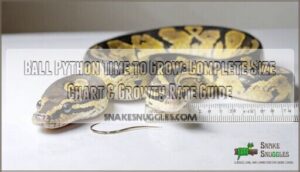This site is supported by our readers. We may earn a commission, at no cost to you, if you purchase through links.

Your snake’s growth journey isn’t a sprint—it’s more like a marathon with distinct phases.
Hatchlings start tiny at 10-17 inches, then experience rapid growth during their first two years before things slow down considerably.
Adult females typically reach 4-5 feet and weigh up to 1,800 grams, while males max out smaller at 3-4 feet and 1,200 grams.
Growth rate depends heavily on genetics, feeding consistency, and environmental conditions, and getting the timing right isn’t just about patience—specific feeding schedules and housing adjustments can make or break your snake’s development potential.
Table Of Contents
- Key Takeaways
- Ball Python Growth Stages
- Average Growth Rate of Ball Pythons
- Factors Affecting Ball Python Growth
- Male Vs Female Ball Python Growth Patterns
- Optimal Feeding Practices for Healthy Growth
- Monitoring Your Ball Python’s Growth
- Common Growth Issues in Ball Pythons
- Maximizing Your Ball Python’s Growth Potential
- When Do Ball Pythons Stop Growing?
- Frequently Asked Questions (FAQs)
- How long do ball pythons grow?
- How long does it take a ball python to hatch?
- When does a ball python reach adulthood?
- How long should a ball python be?
- Do ball pythons stop growing?
- Why do ball pythons grow so fast?
- How quickly do ball pythons grow?
- Can you leave a heat lamp on 24/7 for ball python?
- Is a 3 year old ball python an adult?
- How fast is a full grown python?
- Conclusion
Key Takeaways
- Your ball python will reach full size in 3-4 years, with females growing larger (4-5 feet) than males (3-4 feet), so don’t expect overnight results—this growth journey requires patience and consistent care throughout multiple distinct stages.
- You’ll need to adjust feeding schedules as your snake grows: feed hatchlings every 5-7 days, juveniles weekly, sub-adults every 10-14 days, and adults every 2-3 weeks with prey that’s 10-15% of their body weight.
- Your snake’s environment directly impacts growth rate—maintain temperatures between 88-92°F on the warm side and 78-80°F on the cool side, with 50-60% humidity to support proper metabolism and shedding.
- You should track your python’s weight monthly and length every few months to monitor healthy development, watching for warning signs like rapid weight loss, stunted growth, or obesity that require immediate attention.
Ball Python Growth Stages
Your ball python goes through four distinct growth stages from hatching to adulthood, each with specific size milestones and care requirements.
Understanding these stages helps you track your snake’s development and adjust feeding schedules as they grow from a 10-inch hatchling to a full-sized adult.
Hatchling
Your ball python hatchling starts out measuring 10-17 inches long and weighs around 50-100 grams.
This stage sets the foundation for healthy ball python growth throughout their life.
Hatchling care requires attention to detail since these tiny snakes are particularly vulnerable to stress and environmental changes.
Key hatchling requirements include:
- Initial feeding with appropriately sized prey (pinkie mice work well)
- Enclosure setup with proper heating zones and secure hiding spots
- Monitoring for first shed within 1-2 weeks after hatching
- Watching for common issues like feeding refusal or dehydration
Juvenile
Your hatchling has officially entered the juvenile stage, where ball python growth rate accelerates dramatically.
Juvenile python growth occurs between 6-18 months, with your snake reaching 2-3 feet in length.
During these python growth stages, ball python size increases rapidly, requiring constant adjustments to care.
Here’s what juvenile ball python ownership demands:
- Juvenile Enclosure: Upgrade to at least a 40-gallon tank as your snake outgrows smaller spaces
- Juvenile Feeding: Increase prey size to adult mice and feed every 7-10 days
- Juvenile Shedding: Expect more frequent sheds as growth accelerates
- Juvenile Health: Monitor ball python weight gain of 50-100 grams monthly
Juvenile Handling becomes easier as your snake develops confidence and strength.
Sub-Adult
Your juvenile python’s entering the subadult stage around 18 months, measuring 3+ feet long.
Growth spurts become less dramatic as your ball python growth rate slows substantially.
Temperament changes emerge—they’re developing their adult personality and may become more defensive.
Subadult feeding shifts to larger prey every 10-14 days instead of weekly meals.
Time for an enclosure upgrade to accommodate their increased size and strength.
Handling techniques should adapt to their growing confidence and potential attitude adjustments.
Monitor their feeding schedule python carefully as appetite may fluctuate during this python growth stages period.
Adult
By age three, your ball python reaches adult size and enters its mature phase.
Growth practically stops, though some snakes add minimal bulk over their lifespan.
At breeding maturity, you’ll notice significant size differences between males and females – a key milestone in your python growth chart.
Adult ball python characteristics include:
- Weight plateau at 1,000-1,500g (males) or 1,500-3,000g (females)
- Adult python size ranging 2-3 feet (males) to 3-5 feet (females)
- Need for enclosure upgrade to accommodate final dimensions
- Reduced feeding frequency as metabolism slows
Average Growth Rate of Ball Pythons
Your ball python growth rate peaks during the first three years, with hatchlings adding 10-12 inches annually.
Captive vs. wild conditions substantially impact this growth timeline – captive pythons reach full size in three years while wild ones take four to five.
Expect a monthly increase of 2-3 inches initially, then growth tapers off dramatically.
Size variation between individuals is common, making growth charts helpful guides rather than strict rules.
Most python growth stages plateau around year four, though slight growth continues throughout their lives.
They require specific temperature and humidity to thrive.
Factors Affecting Ball Python Growth
Your ball python’s growth rate isn’t set in stone—several key factors directly influence how quickly your snake reaches its full size.
Understanding these variables helps you provide the best care and guarantees your python develops at a healthy pace.
Genetics
Your snake’s genetics act like a blueprint for its growth potential.
Morph genetics and inherited traits from parent pythons substantially influence final size, with some bloodlines naturally producing larger or smaller offspring.
Selective breeding has created lines with specific size characteristics, while certain mutations can impact growth rates.
However, genetic health plays a bigger role than morph type in determining robust development.
Think of genetics as setting the ceiling—your python’s mutation impact establishes maximum potential, but proper care determines whether it reaches that genetic ceiling.
Ball pythons’ ultimate size is also affected by a balanced diet and environmental conditions.
Diet and Feeding Schedule
Your ball python’s diet directly shapes its growth trajectory. Proper nutrition fuels healthy development, while inconsistent feeding stunts potential.
Feed appropriately sized prey (10-15% of body weight) every 7-14 days based on age. Rats offer superior nutrition compared to mice for ideal python feeding schedule results. Many owners find success when sourcing python feeders online.
Consider these key factors:
- Prey variety prevents nutritional deficiencies – rotate between different rodent types
- Food sourcing quality matters – choose reputable suppliers to avoid feeding problems
Monitor hydration needs and avoid unnecessary supplementation.
Environmental Conditions
Beyond proper nutrition, your python’s environment plays a major role in healthy growth.
Temperature gradients between 88-92°F on the warm side and 78-80°F on the cool side support essential metabolism.
Maintain humidity levels at 50-60% for proper shedding.
Python enclosure size should accommodate growth, while multiple hiding spots reduce stress.
Lighting needs include natural day-night cycles to regulate behavior.
Providing adequate basking spot temperatures is vital for their health.
| Environmental Factor | Optimal Range | Growth Impact |
|---|---|---|
| Temperature | 88-92°F (warm) / 78-80°F (cool) | Supports metabolism |
| Humidity | 50-60% | Enables proper shedding |
| Enclosure Size | 36"x18"x12" minimum | Prevents stress |
| Lighting | 12-hour cycles | Regulates behavior |
Health Status
Your ball python’s health status directly impacts growth potential.
Regular checkups with an exotic veterinarian help catch issues early, preventing stunted growth or obesity signs.
Watch for sudden weight loss, appetite changes, or unusual behavior – these red flags signal underlying problems affecting development.
Parasites, respiratory infections, and metabolic disorders can severely limit healthy python growth.
Maintaining proper reptile health through proper husbandry and veterinary care guarantees your snake reaches its full size potential without complications.
Male Vs Female Ball Python Growth Patterns
Your ball python’s gender plays a significant role in determining its growth trajectory and final size. Understanding these sex-specific growth rates helps you set realistic expectations for your snake’s development.
Size Dimorphism becomes apparent early in ball python development. Female ball pythons consistently outgrow their male counterparts, reaching 4-5 feet compared to males’ typical 3-4 feet. This growth disparity isn’t just about length—females develop substantially more body mass and girth.
| Characteristic | Male Ball Python | Female Ball Python |
|---|---|---|
| Adult Length | 3-4 feet | 4-5 feet |
| Adult Weight | 1,000-1,500 grams | 2,000-3,000 grams |
| Maturity Timeline | 16-18 months | 18-24 months |
Weight differences become pronounced during the first year. Males typically plateau around 1,500 grams, while females can exceed 2,500 grams. Female ball python body composition remains denser throughout development, supporting future reproductive needs. These breeding implications make understanding growth patterns essential for long-term care planning.
Optimal Feeding Practices for Healthy Growth
Your ball python’s growth depends heavily on what you feed it and how often you provide meals.
Proper feeding practices are the cornerstone of healthy ball python development and growth potential.
Proper feeding practices guarantee your snake reaches its full size potential while maintaining healthy weight throughout each growth stage.
Prey Size and Type
When selecting optimal prey for your ball python diet, choose rodents weighing 10-15% of your snake’s body weight.
Frozen vs. live prey both work, though frozen-thawed reduces injury risks.
Avoid wild prey risks like parasites by using captive-bred rodents.
Prey variety including mice and rats promotes balanced rodent nutrition.
Proper prey size matching your python’s thickest body section promotes healthy python feeding and steady growth.
Feeding Frequency
Your ball python’s feeding frequency directly impacts its growth potential and overall health. Getting the ideal frequency right prevents power feeding while supporting steady development.
Follow these age-based guidelines for ball python feeding:
- Hatchlings (0-6 months): Every 5-7 days with appropriately sized prey
- Juveniles (6-18 months): Weekly feedings to maintain consistent growth
- Sub-adults (18+ months): Every 10-14 days as metabolism slows
- Adults (3+ years): Every 2-3 weeks for maintenance
Always prioritize frozen-thawed food for safety. Monitor prey digestion and adjust for seasonal changes or refusal reasons.
Monitoring Your Ball Python’s Growth
Tracking your ball python’s weight and length measurements provides essential data to confirm healthy development and catch potential problems early.
You’ll need to weigh your snake monthly and measure its length every few months to create a reliable growth record that helps you adjust feeding schedules and identify health concerns.
Weight Tracking
Tracking your ball python’s weight provides concrete data about growth progress and overall health.
Use a digital scale for scale accuracy, weighing your snake weekly after defecation for consistent results. Record measurements in a python weight chart to identify patterns and weight fluctuations over time.
Digital tools like smartphone apps can streamline this process. Consider using a specialized scale for accurate readings.
Compare your recordings against established weight benchmarks for your snake’s age and sex. An ideal weight varies by individual, but steady gains indicate healthy development.
Watch for sudden changes that might signal feeding adjustments or health concerns requiring veterinary attention, and remember that healthy development is key.
Length Measurements
Regular ball python length measurements reveal vital growth patterns and help you spot potential issues early.
Place your snake on a flat surface and gently stretch from nose to tail tip using a measuring tape. Document these record lengths monthly to create your personal python growth chart.
As hatchlings, they typically measure between 10-17 inches.
Measuring Techniques for accurate ball python size tracking:
- Use a cloth measuring tape for flexibility around curves
- Measure when your snake is calm and relaxed
- Record measurements in the same position each time
- Note any growth discrepancies or unusual size variations
Common Growth Issues in Ball Pythons
Even with proper care, you’ll sometimes encounter growth problems that can affect your ball python’s health and development.
Recognizing issues like stunted growth, obesity, or rapid weight loss early helps you take corrective action and guarantee your snake reaches its full potential.
Stunted Growth
While tracking your python’s progress reveals healthy development patterns, sometimes growth stalls unexpectedly.
Stunted growth affects many ball pythons when underlying issues disrupt normal development. Identifying stunting early prevents long-term complications and supports your snake’s wellbeing.
Ball python growth stunting occurs when development substantially slows or stops entirely. Several factors contribute to this concerning condition:
- Parasitic infections – Intestinal parasites block nutrient absorption, preventing healthy weight gain and metabolic issues
- Inadequate nutrition – Improper prey size or feeding frequency limits essential python growth factors
- Environmental stress – Poor habitat conditions suppress appetite and disrupt ball python health
- Genetic predisposition – Some lineages naturally exhibit slower growth patterns requiring veterinary help for proper assessment
Prevention focuses on maintaining consistent feeding schedules, ideal habitat conditions, and regular health monitoring.
Reversing stunting requires addressing root causes through improved husbandry practices.
Obesity
Overfeeding risks create serious health complications in ball pythons, leading to organ strain and shortened lifespans.
Identifying obesity becomes easier when you notice your snake’s circular cross-section and stretched scales.
Prevention strategies include measuring prey weight against your python’s body weight, and proper weight management through controlled feeding schedules prevents dangerous health issues from developing.
Rapid Weight Loss
Your python’s rapid weight loss signals trouble that demands immediate attention. While seasonal fasting occurs naturally, prolonged appetite loss combined with weight decline indicates serious underlying illnesses or parasite infections requiring swift action.
- Stress factors: Environmental changes, improper temperatures, or handling issues can trigger appetite suppression
- Dehydration signs: Sunken eyes, sticky saliva, and loose skin indicate critical fluid loss
- Veterinary intervention: Professional diagnosis prevents permanent health complications from progressing untreated
Maximizing Your Ball Python’s Growth Potential
Helping your ball python reach its full growth potential requires a thorough approach that goes beyond basic care. Proper nutrition forms the foundation—offer appropriately sized prey every 5-7 days for juveniles and every 10-14 days for adults. Your python growth chart will reflect these feeding decisions.
Maintain consistent temperatures between 78-92°F with proper humidity levels around 50-60%. Enrichment strategies like adding climbing branches and varied hiding spots reduce stress while promoting natural behaviors that support healthy ball python growth.
Consider supplementation options carefully—while not always necessary, calcium dusting prey occasionally can benefit growing snakes. Morph influence may affect growth rates, with some morphs naturally growing slower than others.
Monitor your python’s growth rate weekly, documenting weight and length changes. Breeding considerations become relevant once snakes reach maturity, typically around 1,500 grams for females. Remember, consistent python care and patience yield the best results for ideal development.
When Do Ball Pythons Stop Growing?
Building on maximizing growth potential, understanding when your ball python reaches its adult size helps set realistic expectations.
Ball pythons never truly experience complete growth cessation. Instead, they hit growth plateaus around three to five years old. Wild vs captive environments affect this timeline—captive pythons often reach maximum size faster due to consistent feeding. A key factor includes consistent temperature gradients to aid metabolism.
Here’s what happens during their python lifespan:
- Your heart will swell watching rapid growth transform your tiny hatchling into a magnificent adult
- You’ll feel proud knowing your care helped them reach their genetic potential
- Peace comes naturally when growth stages stabilize into predictable adult size patterns
Ball python adult length varies: females reach 4-5 feet, males stay around 3-4 feet. Lifespan growth continues minimally throughout their 20-30 year lives, making ball python growth a lifelong journey rather than a destination.
Frequently Asked Questions (FAQs)
How long do ball pythons grow?
Like ancient serpents reaching maturity, your ball python will grow for 3-5 years before reaching full size.
They’ll hit their adult length around three years, though wild pythons take longer than captive ones.
How long does it take a ball python to hatch?
Ball python eggs take about 55 to 60 days to hatch after being laid. You’ll need to maintain proper temperature and humidity during incubation for successful hatching of healthy baby pythons.
When does a ball python reach adulthood?
Your ball python reaches adulthood between 3-5 years old.
Males typically mature faster around 2-3 years, while females take 3-5 years.
They’ll reach full size and reproductive maturity during this timeframe.
How long should a ball python be?
Adult females stretch 3-5 feet while males stay compact at 2-3 feet.
You’ll see your python reach full length around three years old, though genetics and feeding habits can push some individuals slightly beyond these typical ranges, influenced by genetics.
Do ball pythons stop growing?
Yes, your ball python will eventually stop growing.
They reach full size around 3-5 years old, then growth plateaus substantially.
After that, they’ll maintain their adult length and weight throughout their lifespan.
Why do ball pythons grow so fast?
Captive ball pythons reach 36 inches within three years compared to wild pythons taking four to five years.
You’re providing consistent meals, ideal temperatures, and stress-free environments that accelerate their natural growth rate substantially.
How quickly do ball pythons grow?
Your python’s growth happens remarkably fast during their first three years.
They’ll stretch from 10 inches as hatchlings to 2-3 feet by year one, reaching full adult size within three to five years total.
Can you leave a heat lamp on 24/7 for ball python?
Like a vigilant guardian’s torch, heat lamps shouldn’t burn continuously.
You’ll need day-night temperature cycles for your python’s health.
Use timers or ceramic heat emitters for nighttime warmth, maintaining proper thermal gradients, with thermal gradients being crucial.
Is a 3 year old ball python an adult?
At three years old, your ball python is considered an adult.
Most reach full size by this age in captivity, though they’ll continue growing slowly.
You’ll notice they’ve reached sexual maturity and their adult proportions.
How fast is a full grown python?
Lightning-fast doesn’t describe ball pythons at all.
You’ll find these gentle giants move surprisingly slowly, typically slithering at just 1 mile per hour.
They’re built for stealth and patience, not speed races.
Conclusion
Ever wondered why some ball pythons thrive while others struggle? Understanding ball python time to grow requires patience, consistency, and proper care techniques.
You’ve learned that genetics, feeding schedules, and environmental conditions directly impact your snake’s development. Monitor weight and length regularly, adjust feeding based on growth stages, and maintain ideal temperatures.
Remember, healthy growth takes 3-4 years—rushing the process often backfires. Focus on consistent care practices, and your ball python will reach its full potential naturally, with proper care.
- https://www.xyzreptiles.com/how-fast-do-ball-pythons-grow
- https://pangovet.com/pet-health-wellness/snakes/how-fast-do-ball-pythons-grow
- https://www.petmd.com/reptile/ball-python-care-sheet
- https://reptile.guide/ball-python-size
- https://www.quora.com/How-long-does-it-take-for-a-ball-python-to-grow-to-full-size
















